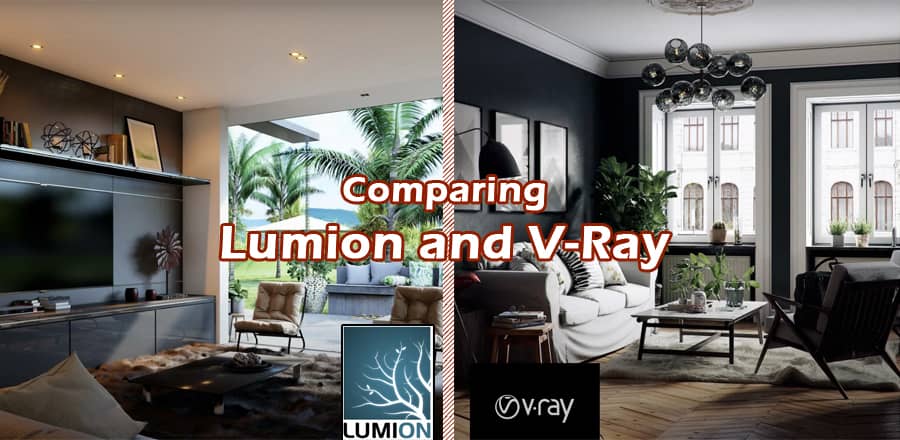There is no doubt that both rendering plug-ins are much similar and provide you with some seamless advantages, but they do have some differential attributes which we will know so that it will be easy to choose between these two extensions.
It’s challenging to directly compare them because of the vast differences in their features and how you integrate them into your SketchUp workflow. Finding which one is best for you is more crucial than trying to determine which is the best.
The crucial factors you must take into account when choosing between the two programs are divided into three categories;
There is no doubt that both rendering plug-ins are much similar and provide you with some seamless advantages but they do have some differential attributes which we will know so that it will be easy to choose between these two extensions.
It’s challenging to directly compare them because of the vast differences in their features and how you integrate them into your SketchUp workflow. Finding which one is best for you is more crucial than trying to determine which is the best.
The crucial factors you must take into account when choosing between the two programs are divided into three categories;
- Incorporating V-Ray and Lumion into your workflow,
- Rendering act,
- Key divergences.
Lumion
Due to its simplicity and promise of quick results, Lumion has made significant advancements in recent years despite the fact that its early renders were of poor quality and unrealistic.
The only purpose of Lumion is rendering; it is not intended for modeling. It has a vast library of all types of objects, particularly external ones, as well as numerous textures, effects, and realistic environments.
The most recent Lumion versions are excellent; the renders are remarkably accurate, the objects and textures are of much higher quality, and the sky has more realistic day and night options.
V-Ray
V-Ray is a render engine that can be combined with 3D programs like 3ds max Sketchup, Revit, and others as a plug-in. Because it displays the texture and materials in renderings realistically, it is renowned for its great performance in rendering operations.
Since it provides users with a variety of lighting options, including spots, IES illumination, domes, rectangular lights, and of course sunlight, lighting in V-Ray is a crucial component.
You can really manage the image’s size and resolution with V-Ray, and you can even run low-resolution render tests to make sure that the textures, lighting, and effects work together flawlessly.
Due to the fact that V-Ray is an integral part of modeling software, its configurations are not known for being the easiest to use, but if you keep them simple you will have no problem setting it up.
Comparing V-Ray and Lumion Attributes
| Lumion | V-Ray | |
| In terms of Performance and Speed | A render with Lumion takes a few seconds to a few minutes; however, a render with V-Ray might take a while, especially if you want greater quality. This is because a render with Lumion is done automatically, whereas a render with V-Ray is customized to the user’s demands. | Timing is crucial in this task; many architects operate under pressure and are constantly looking for a quicker solution to complete the project with quality results. V-Ray, which renders more slowly, Lumion, has this option as well. While Lumion has incredible skills in external scenes, V-Ray offers outstanding performance in terms of interior and exterior renderings, lighting, and editing interiors. |
| In terms of a learning curve | The fact that Lumion is not difficult to use, especially for time-constrained architects, that it is simple to configure, and that it renders quickly-in just a few seconds or minutes-is what really sets it apart from other render software. | If you don’t have experience with 3d software, you can use Lumion to do image renders and animations and it will give you reasonably good results because it contains a lot of things that can make the process of rendering scenes way easier. V-Ray offers limited functionality in this regard because you are expected to do this yourself, which can take a little bit longer and can be harder as well. The project will take longer if you utilize V-Ray to render photos and other modeling, animation, and other tools; you also need practical experience to produce the desired results. |
| In terms of the complexity of your models | There was no comparable material collection available with V-Ray. To include objects in your SketchUp model, you could either download them from the 3D storehouse or similar websites, build the objects yourself, and then use V-Ray to set up the material settings so they render nicely. However, the latest version of V-Ray 5 now comes with Cosmos, a curated 3D model library that has been designed to be render-ready and of high quality. | The goals you set for your pose are crucial to giving your representations life, and the more realistic your final interpretations can be, the higher quality objects you use. One of the key features of Lumion is its material library, which contains over 6,000 render-ready objects that can be quickly added to your simulation. These objects include realistic trees and flowers, goals and furniture, people and pigs, parties and vehicles, and more. All of these objects have the proper documentation and are specified to render beautifully. |
For more information, please watch the video tutorial
Wrapping it up
After discussing all of the positive and negative aspects of the two programs and highlighting each one’s strong features, it can be said that both are effective at rendering, with a few minor variations depending on the requirements of the architect.
In comparison to V-Ray, which is primarily geared toward architects and very realistic projects, Lumion provides good choices and an integrated rich library full of many types of objects. It is also simpler to use for everyone.


